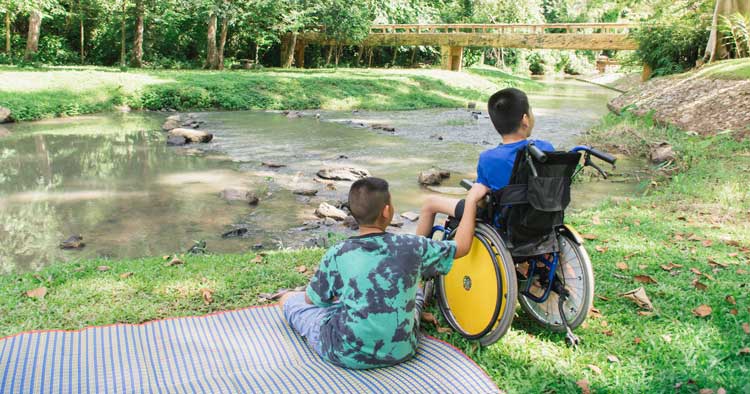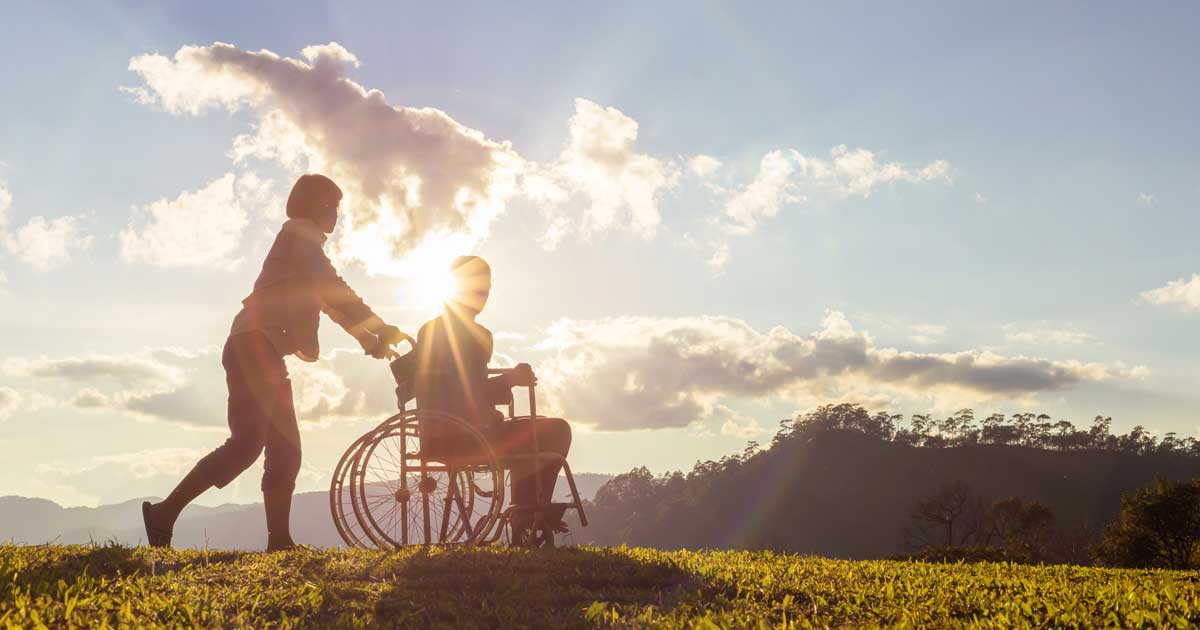Zak Kissel is a graphic designer, a DJ, and a Dallas Cowboys fan. When he was diagnosed with Duchenne Muscular Dystrophy at 18 months, his mom Megan, a Registered Nurse and Certified Nursing Assistant, became his fiercest advocate. They are uniquely positioned to provide tips to increase accessibility at summer camp for kids with neuromuscular disorders because they are also a camp family.
Each summer, Zak attends Camp Promise, a one-week camp in Colorado specifically designed for kids and young adults with Duchenne. Zak and Megan know that not every camp has the budget and capacity to make large-scale changes to its physical campus and equipment.
That said, they say there are steps all camps can take to create positive experiences at summer camp for kids with neuromuscular disorders, even if they’re not exclusively for these kids.
Their advice, which we’ll be going into detail on, is:
- Get advice and feedback regularly from parents and campers
- Create an intentional buddy system
- Develop new activities with accessibility built in
- Find ways to alter existing camp activities
- Be flexible with schedules and participation requirements
Zak will always face challenges operating in a world not designed for people with Muscular Dystrophy, but he believes that all kids should have the opportunity to attend camp. He and Megan know the value of summer camp, and hope their suggestions can open these experiences to more kids.
Tip #1: Get feedback early and often about camp for kids with neuromuscular disorders
No matter how much research and planning you do to create positive experiences at summer camp for kids with neuromuscular disorders, you have to understand that each camper is going to be different. The same diagnosis will manifest in very different ways for every single kid.
The good news for camps, according to Megan, is that you have individualized experts to reach out to for advice: the campers themselves, and their families.
One of the best things about camp on the whole, and also for Zak specifically, is the option to try new things. Megan says that if camp leaders know ahead of time what he likes to do, they can start there, within his existing comfort zone and confidence. In Zak’s situation, being able to do five things that he’s done before, that he enjoys, and that don’t make him anxious, means he will be more likely to try one new thing. Alternatively, if he feels he has no say in his activities, he might shut down entirely.
Megan hopes camp directors understand that kids with neuromuscular disorders aren’t guaranteed to participate in an activity just because it’s accessible to them. She says that there can be a tendency to ask a camper what they have the physical ability to do, and then create activities based on that. She explains that just because they can do something, it doesn’t mean they’re comfortable actually doing it.
Asking ahead of time gives directors and counselors the information they need to plan. That’s not where the feedback cycle should end. Megan also encourages camps to get feedback in real time from kids whose needs they’re trying to suit. You can ask simple questions like:
- How did that go?
- What didn’t work?
- How can we do a better job?
Doing this one-on-one as opposed to in larger groups will likely be more comfortable for these campers. For example, if you ask a large group of campers if they liked an activity, and most of them say it was amazing, Zak would be less likely to advocate for himself if he didn’t feel comfortable doing it. Similarly, if many campers complain about something being too easy, but for Zak it was physically challenging, he’d keep quiet.
Megan also points out that this evaluation step is most effective between the campers and someone with a leadership role. There’s a chance that the issues with a particular activity could be about the counselors running it. In such an instance, Zak would not be able to give honest feedback.
Before, during, and after camp, Megan says you should ask families and campers for advice. No one knows what works for Zak better than he does.
Zak will always face challenges operating in a world not designed for people with Muscular Dystrophy, but he believes that all kids should have the opportunity to attend camp.
Tip #2: Use the buddy system to provide support and encourage participation from day one
 Many camps use the buddy system and pair campers throughout the summer, or for specific activities. At some camps, when there is a camper who needs more support, a counselor is often paired with them instead. Megan and Zak agree that a system of pairing can be helpful. This approach is something to consider as you work to plan activities at camp for kids with neuromuscular disorders.
Many camps use the buddy system and pair campers throughout the summer, or for specific activities. At some camps, when there is a camper who needs more support, a counselor is often paired with them instead. Megan and Zak agree that a system of pairing can be helpful. This approach is something to consider as you work to plan activities at camp for kids with neuromuscular disorders.
Megan’s perspective is that at a camp geared toward all campers regardless of physical abilities, kids with limited mobility may already feel anxiety about being different or needing more accommodations. Having to advocate for themselves, particularly if they are first-time campers, can be a challenge. Being paired with a counselor, or a camper with more experience, can alleviate some of the hesitation that might keep them from sharing their needs.
These campers may also hesitate to participate in activities, even those that have adaptations to suit their needs. A buddy who they know and trust can help with encouragement.
One caveat, according to Megan, is that these pairings need to be intentional. She remembers a summer when Zak was paired with a very introverted counselor. As a shyer, quieter person himself, Zak had no one to help break him out of his shell. So, if your camp does take this approach, make sure to choose partner counselors or campers who are more extroverted.
Tip #3: Come up with new accessibility activities that everyone can be part of

Every camp has the activities that it’s known for, the ones campers look forward to each summer, the ones that have stories going back as far as the camp’s history. While there are always opportunities to evolve existing activities to increase accessibility (see Tip #4), Megan does encourage camps to get creative and add new activities that are easier for all kids to participate in right from the start.
One camp activity that is the highlight of every summer for Zak is Kangaroo Court. In this mock justice game, campers end up “punishing” counselors, and making them do any number of crazy actions. Whether this exact premise fits with your camp, the approach that works is that the physical challenges aren’t done by the campers, but rather directed by them. So many camp games can be flipped to allow the campers to call the shots, which removes the physical participation requirement.
Wheelchair painting is another camp activity that really stood out for Zak at camp. Counselors spread out a large piece of canvas cloth, and campers were able to roll their chairs through washable paint and create designs. What makes this approach particularly effective is that it actually gives able-bodied campers a new way to participate as well, as they can walk in the paint and make designs with their feet. At the end of camp, the canvas cloth was cut into small squares and each camper was sent home with a section as a souvenir.
Megan also encourages camps to think beyond physical activities. Zak and his friends love trivia, which is a great opportunity to challenge campers’ knowledge and reward success without movement or exercise. Overall, Megan encourages camps to focus on campers and what they like to do, and build new activities around that.
These campers may also hesitate to participate in activities, even those that have adaptations to suit their needs. A buddy who they know and trust can help with encouragement.
Tip #4: Find ways to include campers in existing camp activities
As noted in the previous tip, coming up with new events doesn’t mean that camps have to abandon the ones that happen every summer. It also doesn’t mean that every single activity can be adapted. Still, with a little thinking outside the box—which camp people do as well as anyone—there are a lot of creative options.
A nature walk is hard to recreate for campers in wheelchairs, but flora and fauna identification can be brought out of the woods. This could be made into a partner activity. The camper with limited mobility could have a list, and direct their buddy to find specific leaves or flowers based on their description. Megan says that Zak particularly enjoys any activity where he gets to be a manager or controller, and someone else acts as his legs.
Megan also suggests finding specific roles for campers within activities where they might not be able to do everything. At Zak’s camp, there is a dance party on the final night. While he may not be able to participate in the traditional sense, he’s given a role that suits him perfectly: DJ. Getting to know campers, and what they love to do, means you can add new roles into activities to suit their existing confidence.
One small piece of advice Megan offers is related to ice breakers. It’s as simple as making sure the get-to-know-you questions don’t immediately separate the kids with neuromuscular disorders from those who are able-bodied. Often counselors will ask for campers’ favorite sports, the furthest place they’ve traveled, or their favorite food. Some campers can’t play sports, find it difficult to board planes, and are fed through a feeding tube. These questions immediately create separation. Megan says instead to ask open-ended questions, such as:
- What’s one thing you’re good at?
- What’s one thing you’re terrible at?
- Who is a person you admire?
Finally, when it comes to activities, Megan says that asking peers at other camps how they increase accessibility is a great approach. Just because your team can’t conceive of how to adjust an activity, doesn’t mean there’s no way to do it. Even if it might require special equipment, there are opportunities to rent, borrow, or even seek donations.
Tip #5: Institute schedule flexibility

At Zak’s camp, which is designed specifically for people with Duchenne, it’s understood that each camper is going to have their own morning and evening routine. In Zak’s case, it takes him two hours to get up and ready for the day. Some kids take longer and some have extended nighttime routines. This can be a challenge at camps that have stricter wake-up times, morning activities, and bed times.
One suggestion from Megan is to allow for floating bed and wake-up times, and flexibility for morning and evening activities. If this is built into your camp’s approach, the campers with neuromuscular disorders who may have different needs and routines are less likely to feel left out or excluded.
Another need for flexibility is based on some campers’ energy levels for activities. What may feel like no big deal for an able-bodied camper is something that could exhaust Zak completely. Allowing for time-off between activities can help with this. At Zak’s camp, the arts and crafts room is open all day. This way, if he’s overtired from other activities, or chooses to opt out of one that is beyond his comfort level, he’s not just sitting around on his own with nothing to do.
Give all kids the camp experience
From Megan’s perspective, the final piece of inclusivity is being comfortable when kids choose to opt out. While it’s always helpful to encourage campers to test their boundaries, that might mean something very different to a camper in a wheelchair. Simply put, it has to be okay for Zak to opt out without feeling pressure or resulting disappointment and negativity.
At camp, it can be easy to get stuck thinking that there’s only one way to participate. To really increase accessibility, camp leaders need to consider new options, develop alternative activities, ask campers what they want to do, and understand that sometimes simply observing other campers is enough.
The end goal, according to both Zak and Megan, is that all campers, regardless of the accommodations they need, feel like they are part of a community. If any environment is capable of making that happen, it’s summer camp.
